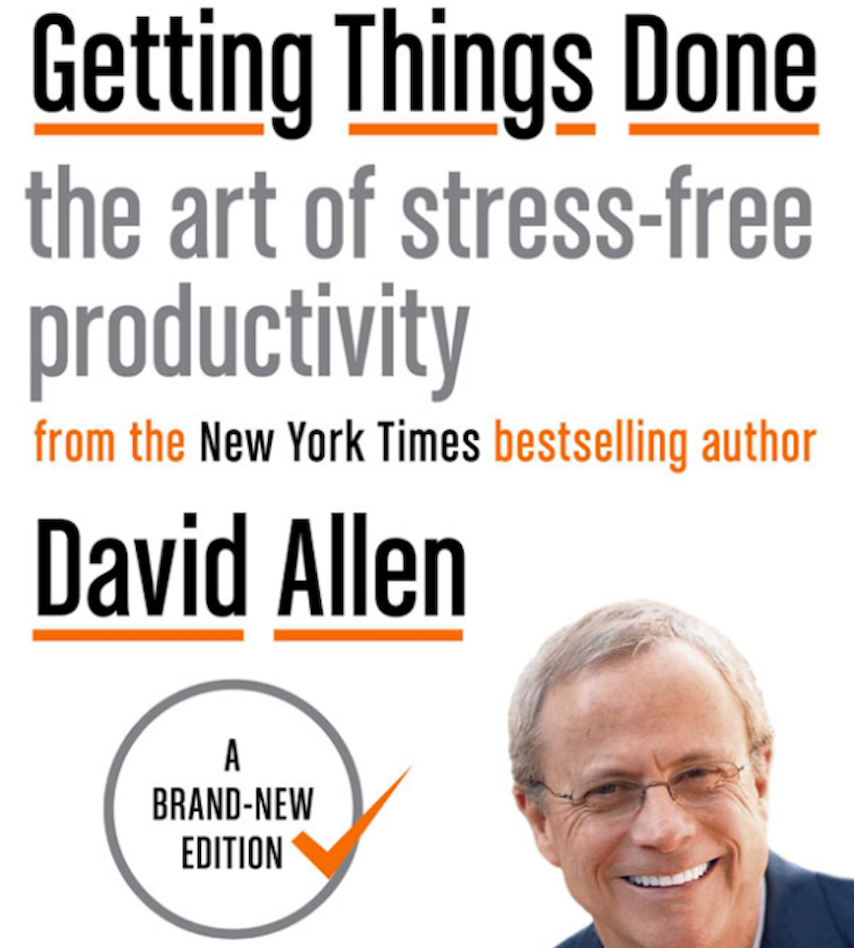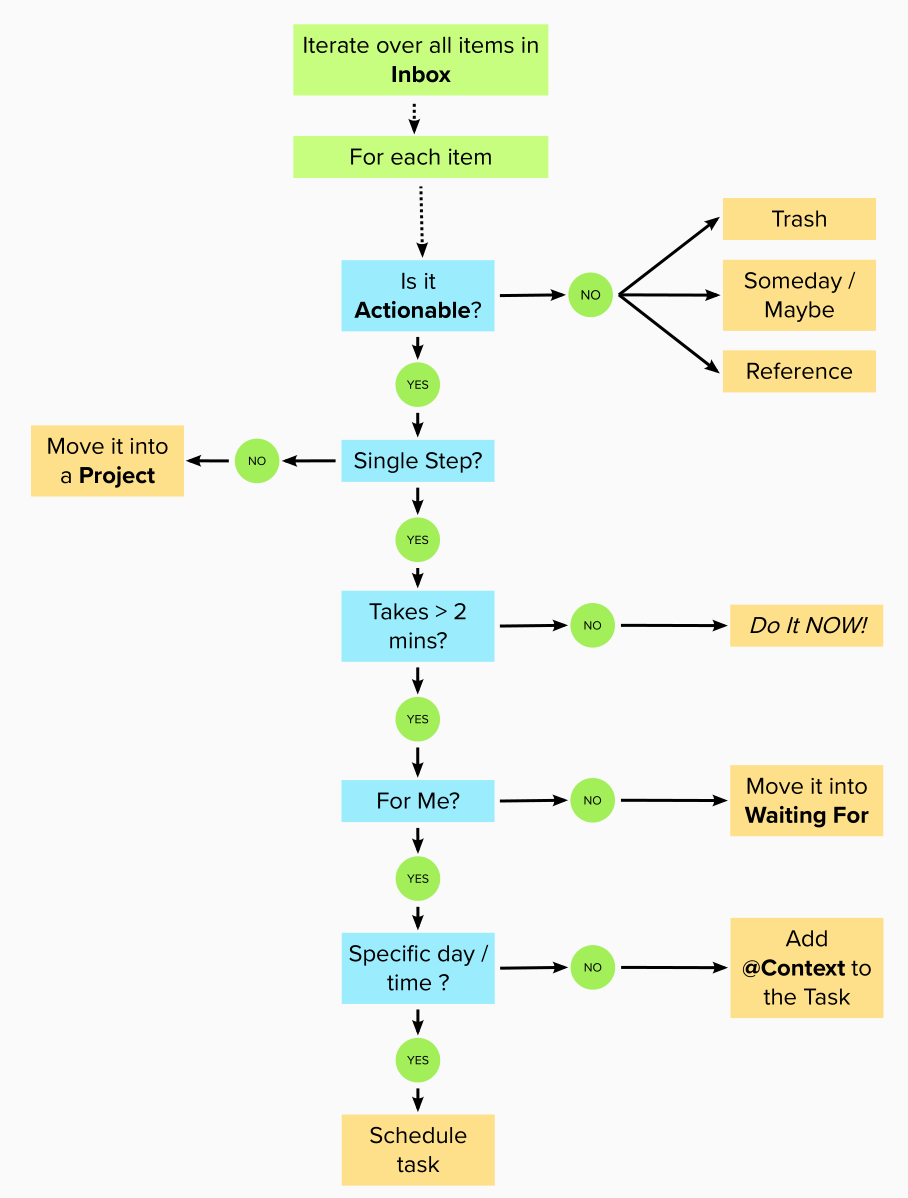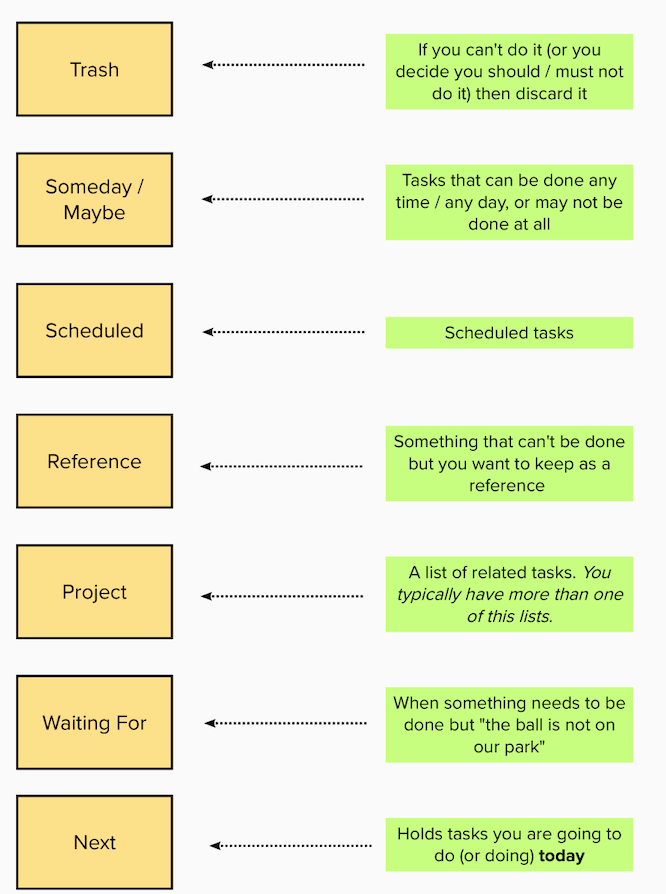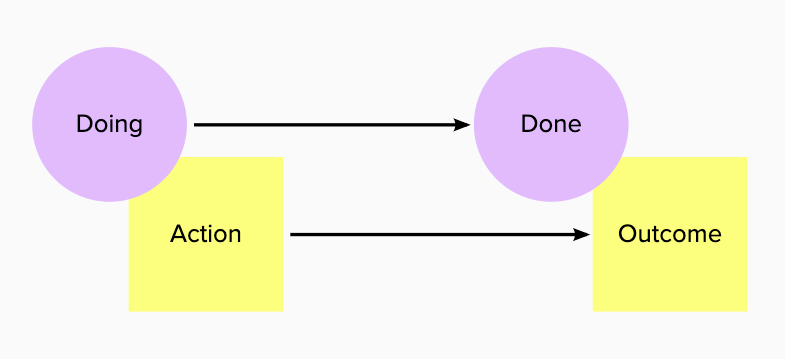Getting Things Done
Notes and Quotes
The Art of Stress-Free Productivity
by David Allen
 https://gettingthingsdone.com/what-is-gtd/
https://gettingthingsdone.com/what-is-gtd/
The best place to succeed is where you are with what you have. — Charles Schwab
The Overall Workflow
Here is an overview of the steps to put GTD in practice.
 Made with http://mural.co/
Made with http://mural.co/
The Process and Organise Workflow
This step is key to make sure every item will get the appropriate handling.
 Made with http://mural.co/
Made with http://mural.co/
List Types in GTD
Just an overview of the most common types of lists used when running GTD.
 Made with http://mural.co/
Made with http://mural.co/
Key Objectives
-
Capture ALL things to be done, in a system outside your head
-
Help you make front-end decisions based on a workable inventory of next actions
-
Curate all the content based on different levels of commitment
Some Facts: Work and Life keeps changing…
-
Organisations are morphing
-
The average Professional is more of an agent
-
Nothing new in general, but frequent change is the constant today
The Ready State we should look for
-
Mind Like Water
-
Look for The Zone
Water is what it is, and does what it does. It can overwhelm, but it’s not overwhelmed. It can be still, but it is not impatient. It can be forced to change course, but it is not frustrated.
Deal with Internal Commitments
-
Internal Commitment not well managed generates stress
-
If it’s in your mind then your mind is not clear: Capture all unfinished items in a trusted system (out of your head)
Managing Action
-
Clearly define Expected Results for any task
-
Define any associated *Next Action *required
-
Clearly define Doing (Action) and Done (Outcome)
 Made with http://mural.co/
Made with http://mural.co/
About Open Loops
-
Capture all incomplete items (those having “should” or “need to” or others)
-
Each Incomplete it’s an Open Loop
-
The Inventory of Open Loops needs to be split into Containers (In-Trays)
-
You need all Open Loops out of your head
-
Always try to clarify what a particular Open Loop means
-
Open Loop Items can be *Actionable *(you must decide the Next Action here) or *Not Actionable *(either Trash, Incubation or Reference)
-
Project: Set of related Actions towards a desired result, that can be achieved within 1 Year
It is better to be wrong than to be vague. — Freeman Dyson
The Next Action
…the next physical, visible behaviour, without exception, on every open loop.
Places to look for Next Actions:
-
Calendar: Needs to happen at a particular date/time
-
Projects Lists
-
Waiting For List
-
Some Day / Maybe List
This Next Actions comes from a Weekly Review of all the above lists.
The process to look for the Next Action
The Four Criteria Model:
-
Context: Can I do this here?
-
Time Available: Do I have time to do this now?
-
Energy: Do I have the *willing and energy *to do this now?
-
Priority: Does this need to be done now?
The Threefold Model:
-
Predefined Work
-
Work that shows up
-
Defining your work
The Six Level Model:
-
Horizon 5: Purpose and Principles
-
Horizon 4: Vision
-
Horizon 3: Goals
-
Horizon 2: Areas of Focus and Accountabilities
-
Horizon 1: Current Projects
-
Ground: Current Actions
The Natural Planning Model:
-
Define purpose and principles
-
Outcome Visioning
-
Brainstorming
-
Organising
-
Identifying Next Actions
The power of Clarifying Outcomes
I always wanted to be somebody. I should have been more specific. — Lily Tomlin
-
Creating Clear Outcomes is one of the most powerful life skills
-
By making outcome clear, you can better define the Next Action.
The Basics of Organization
-
Identify Significant Pieces
-
Sort by Components / Sequences / Priorities
Once you know how to process your stuff and what to organise, you really just need to create and manage lists.
Capturing Stuff
You can only feel good about what you’re not doing when you know everything you’re not doing.
It’s basically about getting all the open loops (stuff to do, unfinished tasks, no matter the size of it) in the “in” tray.
After this, you need to get this “in” tray empty, meaning: You need to go one by one getting all the stuff and: Decide what it is, what it means, and what needs to be done about it.
Processing the “in” tray
Process all the items there, one at a time. Neve put an item back into the “in” tray.
For each item, ask: What is the Next Action about this? This Next Action should be a physical action.
If there item is no actionable, then it should go to one of these lists:
-
Trash
-
Incubation
-
Reference
If the item is actionable, you have 3 options:
-
Do it (now)
-
Delegate (to another person)
-
Defer (put it in a list, to do it later)
After this, the item or project should be out of your mind, if this is not happening, then there is more thinking to be done around this.
The Weekly Review
This is powerful: Here is when you review all your open loops, one by one. This is when you makes sure your lists are up to date and reflex the real current status of whatever you are tracking. Also: This is when you make sure you have your mind free, you should end up with your mind free after the review, you should make sure all the open loops are stored in lists so your mind is free to focus on next actions.
…the Weekly Review is whatever you need to do to get your head empty again and get oriented…
You also need to make sure you have clear Next Actions and clear Outcomes set for all your Open Loops, this way you make it Engaging.
Your work is to discover your work and then with all your heart to give yourself to it. — Buddha
GTD may enhance your relationships
Demonstrating integrity in managing internal and external agreements optimises all of your relationships.
One major outcome about following GTD it’s about becoming a more trustable/accountable person.
When a coworker notice that any agreement you may have (with him/her) is received, processed and organised in a previsible way by you, they begin to trust you in a very unique way.
You in crease the level of self-confidence in your engagement with your world.
But, if you start breaking agreements (with yourself or with others) then your self confidence goes down significantly (and the anxiousness goes up).
How Do You Prevent Broken Agreements with Yourself? If the negative feelings come from broken agreements, you have three options for dealing with them and eliminating the negative consequences: Don’t make the agreement. Complete the agreement. Renegotiate the agreement.
To go back and make sure you don’t break agreements, you need to make sure you collect all the open loops, anything that is held only in your head will take up either more or less attention than it deserves. The reason to collect everything is not that everything is equally important; it’s that it’s not.
That’s it (:



